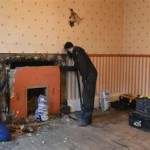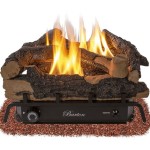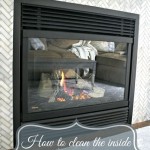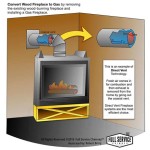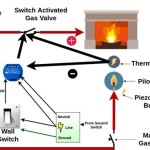Gas Burning Fireplace Logs: A Comprehensive Guide
Gas burning fireplace logs offer a convenient and aesthetically pleasing alternative to traditional wood-burning fireplaces. They provide the ambiance of a real fire without the hassle of sourcing, storing, and burning wood. This article explores the various aspects of gas burning fireplace logs, including the different types available, their installation and maintenance requirements, their advantages and disadvantages, and safety considerations.
Types of Gas Burning Fireplace Logs
Gas fireplace logs can be broadly categorized into two main types: vented and ventless. The key difference lies in whether or not they require a functioning chimney or flue for proper ventilation. Each type has its own set of characteristics and suitability for different applications.
Vented Gas Logs: Vented gas logs are designed to be used in fireplaces with a fully functioning chimney or flue. They produce a more realistic flame appearance due to the higher gas input required to operate them. This higher gas input also results in a significant amount of heat being lost up the chimney, making them primarily for aesthetic purposes rather than efficient heating. Vented logs must be used in a fireplace that meets specific dimensional requirements and has a working damper that is fully open during operation. Failure to do so can result in carbon monoxide poisoning.
Vented gas logs typically consist of a set of individually crafted ceramic fiber or refractory cement logs that are arranged on a grate above a gas burner. The burner is connected to a gas line, either natural gas or propane, and controlled by a manual valve, a remote control, or a wall switch. The flame pattern is designed to mimic the appearance of a natural wood fire, with varying flame heights and ember glow. The realism is further enhanced by features such as bark detailing, split wood textures, and hand-painted finishes.
Ventless Gas Logs: Ventless gas logs, also known as vent-free gas logs, do not require a functioning chimney or flue. They are designed to burn cleanly and efficiently, producing minimal carbon monoxide. However, they do produce water vapor and small amounts of other combustion byproducts, so proper ventilation of the room is still essential. Ventless logs are often considered a supplementary heating source, as they retain more heat within the room compared to vented logs.
Ventless gas logs are typically made from ceramic fiber or refractory cement, similar to vented logs. However, their design is optimized for complete combustion, minimizing the production of pollutants. They often include an oxygen depletion sensor (ODS), which automatically shuts off the gas supply if the oxygen level in the room drops to a dangerous level. This safety feature is mandatory in most jurisdictions. Ventless logs usually come with strict guidelines on room size requirements to ensure adequate ventilation to prevent moisture build up and potential carbon monoxide accumulation.
The choice between vented and ventless gas logs depends largely on the existing fireplace setup and the desired purpose. If a functioning chimney is present and the primary goal is aesthetic appeal, vented logs are a suitable option. If a chimney is not available or the primary goal is supplemental heating, ventless logs are a more practical choice. However, it is crucial to carefully consider the safety implications and ventilation requirements of each type before making a decision, consulting with a qualified professional is highly recommended.
Installation and Maintenance
Proper installation and regular maintenance are crucial for the safe and efficient operation of gas burning fireplace logs. Incorrect installation can lead to gas leaks, carbon monoxide poisoning, and fire hazards. Neglecting maintenance can result in reduced efficiency, increased emissions, and premature failure of the system.
Installation: Installation of gas logs should ideally be performed by a qualified and licensed gas technician or plumber. This professional has the training and experience to ensure that the gas line is properly connected, the burner is correctly positioned, and all safety features are functioning as intended. The installation process typically involves connecting the gas line to the burner, securing the burner in place, and arranging the logs according to the manufacturer's instructions. The gas technician will also test the system for gas leaks and verify that the oxygen depletion sensor (ODS), if applicable, is working correctly.
For vented gas logs, the damper must remain fully open during operation to allow for proper ventilation. Obstructed or partially closed dampers can cause carbon monoxide to build up in the room. For ventless gas logs, it is crucial to ensure that the room meets the minimum size requirements specified by the manufacturer and that there is adequate ventilation. This may involve opening a window or door to allow for fresh air to circulate. The installation process for ventless gas logs may involve connecting remote thermostats or using battery backups for ODS systems.
Maintenance: Regular maintenance is essential to keep gas logs functioning safely and efficiently. At least once a year, the logs and burner should be inspected and cleaned. This involves removing any dust, debris, or soot that may have accumulated on the logs or burner. A soft brush or vacuum cleaner can be used to clean the logs, while a pipe cleaner or small brush can be used to clean the burner ports. Clogged burner ports can cause incomplete combustion and increased emissions.
The gas line and connections should also be inspected for leaks. A soapy water solution can be applied to the connections, and any bubbles indicate a gas leak. If a leak is detected, the gas supply should be shut off immediately, and a qualified gas technician should be called to repair the leak. The oxygen depletion sensor (ODS), if applicable, should be tested regularly to ensure that it is functioning correctly. This can be done by following the manufacturer's instructions or by consulting with a qualified gas technician.
The fireplace and chimney (if applicable) should also be inspected for any signs of damage or deterioration. Cracks in the firebox, damaged flue liners, or obstructions in the chimney can all pose safety hazards. Any necessary repairs should be performed promptly by a qualified professional. Regular maintenance not only ensures the safety of the system but also extends its lifespan and improves its efficiency.
Advantages and Disadvantages
Gas burning fireplace logs offer a number of advantages over traditional wood-burning fireplaces, but they also have some drawbacks. Understanding these advantages and disadvantages can help homeowners make an informed decision about whether or not gas logs are the right choice for their needs.
Advantages: The primary advantage of gas logs is convenience. They eliminate the need to source, store, and haul wood, as well as the mess associated with burning wood. With gas logs, the fire can be started and stopped with the flip of a switch or the press of a button on a remote control. This makes them a convenient option for those who want the ambiance of a fire without the hassle of dealing with wood. Gas logs also produce less smoke and ash than wood-burning fireplaces, resulting in a cleaner and healthier indoor environment. They are also environmentally friendly because they burn cleaner and more efficiently than wood, reducing emissions.
Gas logs can also be a more cost-effective option in the long run. While the initial investment may be higher than that of a wood-burning fireplace, the ongoing costs of fuel and maintenance are typically lower. Gas logs also offer a consistent and predictable heat output, making them a reliable source of supplemental heat. Furthermore, gas logs can be installed in a variety of locations, including rooms that do not have a functioning chimney, provided that ventless models are used and all safety and ventilation requirements are met.
Disadvantages: One of the main disadvantages of gas logs is that they may not provide the same authentic experience as a wood-burning fireplace. While the flame appearance of gas logs has improved over the years, it may still not be as realistic as a natural wood fire. Additionally, gas logs do not produce the same crackling sounds and woodsy aroma that many people associate with a traditional fireplace. Many also prefer the aesthetic of tending to a "real" fire.
Another potential disadvantage is the risk of gas leaks and carbon monoxide poisoning. While gas logs are generally safe when properly installed and maintained, gas leaks can occur if the gas line or connections are damaged or improperly sealed. Carbon monoxide, a colorless and odorless gas, can build up in the room if the fireplace is not properly ventilated. It's important to note that with vented gas logs, most heat is lost through the chimney and with ventless gas logs, there can be moisture and a slight odor depending on the model. It's also important to consider that any gas appliance adds to existing gas consumption, and potentially, to utility bills.
Finally, gas logs may not be suitable for those who are looking for a primary heating source. While ventless gas logs can provide supplemental heat, they are not as efficient as other heating appliances, such as furnaces or heat pumps. Gas logs are also dependent on a gas supply, which may be interrupted during power outages. This can be an issue in areas that are prone to severe weather.

Beautiful Gas Burning Fireplace Log Installations Buffalo Rochester Ny

Majestic 6 Piece Cement With Burner Gas Log Set Vdy24 18d3r North Country Fire

Gas Fireplace Log Bundle Woodstack 18 Harvest Exclusive Masters Services Chimney Sweep And Masonry

Gas Logs Buyer S Guide Capo Fireside
_Vented_2xai-g7_mvhg-zc.jpg?strip=all)
Lone Star Vented Fireplace Gas Log Set 18 Inch

24 Valley Oak Vent Free Log G8 Ansi Bedroom Approved Burner Peterson Real Fyre

Ina Bonfire Vented Gas Log Set Casual Furniture World

Hargrove Mountain Timber Vented Large Gas Log Set With Ember Supreme Burner Kit Natural Only
How To Arrange Gas Logs Howstuffworks

Real Truth Behind Gas Fireplace Logs Clearchimney Com
Related Posts

